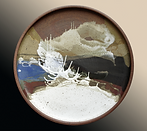
Studio S
P O T T E R Y
WELCOME!
Scroll Down For Additional Information
Providence Christian Academy Cross
As one contemplates the historical significance of what the cross represents, you cannot help but realize the dichotomies that exist in the symbol itself. As an instrument of brutal death it embodied the worst of man. The executed and the executor were partners in a dance of sin and cruelty that defined the state of humanity at the time. God chose to use this abomination to transform the world, when He allowed His son Jesus Christ to be violently sacrificed. This act of compassion altered the direction of human history and the image of the cross. What it represents now is light not darkness, life not death, and forgiveness not punishment.
These dichotomies of contrast are what we strived to convey in this work. With the rusted structure of the outer-cross representing the dark human apparatus of death and destruction, the five belts of reversed angle iron remind us of the thorny crown Jesus wore, and the polished inner-cross chrome center panels signify the love and hope of Jesus Christ. Around the base of the work we selected three colors of stone to represent the rock found in the Holy Land where Jesus was born, taught, and was crucified. The stones with the black cast represent the area around Galilee and Capernaum, those more beige represent the Holy City of Jerusalem, and the stones that appear more pinkish to red are representative of the place where the body of Jesus was placed when removed from the cross on that Good Friday.
Spiritual Works




We also incorporated lights on the interior of the cross to dramatically reinforce this theme at night, which is our very salvation, through Jesus Christ radiates through this human tool of torture, brutality, and death.
The Providence Christian Academy (PCA) cross was constructed with the angle iron that remained from the 2014 addition to the school. To that we consolidated additional metal from Murfreesboro’s Clark Iron and Metal Co., Inc., to complete the sculpture, with the design centering on the contrast of the rusted angle iron and the polished finished panels at the front and back of the piece.
Reflecting the dichotomy of the story of Christ’s Passion, the rusted areas represent the earthly cross and the polished areas represent the spiritual cross. We used acid and water to strategically intensify the rust of the iron and sprayed a chrome finish on the panels. The side panels were sprayed with a clear finish to strengthen the black patina.
The actual structure of the cross was accomplished by welding three pieces of angle iron together to form the corners of the cross and holes were drilled into these pieces in order to attach the front and side panels to the frame. We constructed three sections, two vertical sections and one horizontal, which were bolted together at the apex. The bolts which hold the panels in place create an attractive design element. The ones in the front and back especially convey the flavor of the cruel and harsh Roman legionnaire that participated in the crucifixion.
Only God could take such a tool and transform it into a symbol of hope for all mankind.
Lewis D. Snyder
Jim Carson

Lewis & Eric Snyder